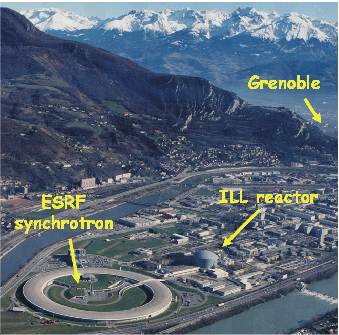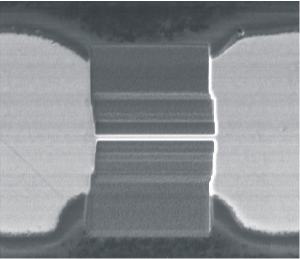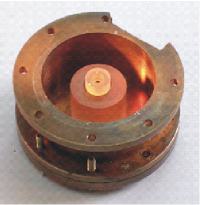PhD Research Opportunities
To apply online please visit the University Postgraduate applications page
In the Condensed Matter Group you would join a small group of like-minded colleagues with a particular interest in how fascinating "emergent" properties arise from Quantum Physics in the arena of condensed matter, particularly at low temperatures. We mainly concentrate on superconductivity and magnetic effects, both of which arise from the correlations between electrons in solids. Our research in recent years has been supported by an EPSRC Portfolio Award, worth £6M, which is enabling joint research with the Electrical Engineering Dept, and there is continuing EPSRC support for other projects. Experimental techniques used in the Condensed Matter Group include sensitive measurements at liquid helium and dilution refrigerator temperatures, growth of thin films by laser ablation, microfabrication, scanning microscopy and the use of neutron, muon and X-ray beams for studying condensed matter at big international facilities. We also collaborate with the active Theory Group in Birmingham, and there is an overlap of interests with the Nanophysics Group.
If doing a PhD with our Group in Birmingham, your project would be your own responsibility: you would not be a small cog in a huge collaboration. You would also have the opportunity to get involved in teaching undergraduates. The Group has 4 full-time academic Staff: Prof. EM (Ted) Forgan, Dr. CM (Chris) Muirhead, Dr. MS (Mark) Colclough & Dr. E (Elizabeth) Blackburn and one University Research Fellow: Dr. EJ (Ed) Tarte in Electrical Engineering, in collaboration with 3 staff in emeritus positions: Prof. WF (Joe) Vinen, Prof. CE (Colin) Gough & Dr. AIM (Alastair) Rae. Both EMF and WFV were recently awarded medals/prizes by the Institute of Physics, in recognition of their research.
Also members of the Group are Research Fellows and Research Students. Nearly all of our current UK students obtained a 1st at undergraduate level. Our research output typically includes 3-4 high-profile (Phys. Rev. Lett., Nature, Appl. Phys. Lett. or Science) publications per year, out of a total of ~ 30 per year. The Group is supported by 2 technicians skilled in cryogenic techniques. To view the members of the group and links to their research pages, please click here.
Current Research Activities
Our research can be described under two very broad headings. One includes the investigation of superconducting & magnetic effects in condensed matter systems. This often involves a group of materials called "Perovskites" - which include oxide structures within which occur: high-Tc superconductivity, colossal magnetoresistance, ferro-electricity, p-wave superconductivity, metamagnetic quantum-critical behaviour, and a host of other phase transitions. However, our underlying aim is to understand, and occasionally exploit, the quantum behaviour of matter, often at low temperatures where this behaviour is more explicit, in whatever systems are most appropriate, and using the techniques in which we are experts.
The other major strand of our research involves the fabrication of microscopic structures in superconductors, to make quantum devices that may show qubit behaviour suitable for quantum computers. This research involves the physics of quantum coherence in objects much larger than an atom, and the interaction of these quantum objects with microwave photons. The techniques employed include focussed ion beam milling to create structures on the submicron scale, and precision measurements at temperatures down to 40 mK above absolute zero.
A detailed profile of our present research areas and possible future projects within these areas are given below.
Probes of Condensed Matter:
neutrons, muons and X-rays (EMF, EB & international collaborators)
Microscopic magnetization dynamics on timescales greater than microseconds
Supervisor: Dr. Elizabeth Blackburn
Dynamics occur on all timescales, from the attosecond up to the kilosecond, but observing the microscopic effects is tricky. Neutron scattering has often been the tool of choice, through inelastic neutron scattering, or by neutron spin-echo, but in both cases the time scale measured is in the nanosecond regime, although neutron spin-echo can be pushed into the microsecond range. A lot of recent effort has focussed on shorter timescales, using x-ray microscopy.
However, a lot of fundamental physics happens on the longer timescales, and this project aims to address the lack of suitable experimental probes here. X-ray photon correlation spectroscopy (XPCS), also known as speckle spectroscopy, fills this particular timescale. The core idea is that scattering off the sample generates a speckle pattern. At some later time, the atoms and magnetic moments have shuffled around, and the speckle pattern is a little bit different. By collecting such patterns over a range of times, time correlations can be measured, giving information on the dynamics. Dynamics in the appropriate time range include domain wall motion in thin magnetic films, or relaxation in frustrated materials like spin glasses or spin ices.
However, most dedicated XPCS facilities around the world use x-rays of a fixed energy, typically 11 keV. This is fine for studying structural dynamics, but the magnetic signal is very small compared to the structural signal. There are several ways to get round this: one could find a spot where only magnetic correlations exist, such as an antiferromagnetic Bragg peak, or one could go to an atomic resonant edge, where the magnetic signal may be enhanced. For a lot of magnetic materials, the relevant x-ray energies are in the soft x-ray regime (100 - 1600 eV).
The goal of this project is to work on developing magnetic x-ray photon correlation spectroscopy and using this technique to investigate a range of dynamical processes in magnetic materials. This will be done in collaboration with the team at Beamline 12 of the Advanced Light Source. Preliminary results on a spin ice are promising!
The austenite-martensite transition in magnetic materials
Supervisor: Dr. Elizabeth Blackburn
The austenite-martensite structural phase transition (a cubic to tetragonal change) has proved to be a very rich field of study, from the initial studies of work-hardening in steel, through to shape memory alloys. When magnetic atoms are present in such materials, the combination of structural and magnetic transformations can lead to extremely rich behaviour, with many potentially useful properties, such as the giant magnetocaloric effect seen in Ni2Mn1-xCuxGa, or the shape memory effect. Even better, these properties can be tuned by varying the composition. Most of these materials are ferromagnetic; however, there are strong indications from magnetization measurements in some of these magnetic Heusler alloys that there are frustrated antiferromagnetic correlations present at low temperatures (Ni50Mn50-xSbx, Ni50Mn50-xSnx, Ni50Mn50-xInx). Preliminary studies on Ni2Mn0.75Cu0.25Ga indicate that electron correlations are key to teasing out the origin of the observed properties.
For a student, this project could involve:
(i) Sample preparation,
(ii) A variety of characterization techniques,
(iii) Neutron diffraction and inelastic spectroscopy,
(iv) X-ray spectroscopy.
Magnetic flux line structures and phase transitions in unconventional and conventional superconductors
Supervisors: Dr. Elizabeth Blackburn, Prof. Ted Forgan
Another focus of our work is the investigation of structures formed by quantised magnetic flux lines in superconductors, and what they tell us about the underlying superconducting state. This research has led to 7 Phys. Rev. Letts and a Science article in the last 4 years on a wide variety of subjects, ranging from p- and d-wave Cooper pairing effects on the vortex lattice structure in unconventional superconductors to vortex motion induced by a current in a low-Tc material.
[When magnetic field lines enter a superconductor, they are surrounded by circulating supercurrents of pairs of electrons. The wavefunction of the pairs ensures that the magnetic flux in each line has the quantised value h/2e. These lines usually make up a hexagonal crystal of "rods" inside the material. The crystal of magnetic field lines can be detected by diffraction of neutrons, which have a small magnetic moment. It was originally assumed that the two electrons making up a "Cooper pair" had zero mutual angular momentum. In recent years unconventional superconductors with L = 1 or 2 ("p- or d-wave") have been discovered].
|
The neutron and synchrotron X-ray sources at Grenoble |
Some years ago, we used neutron and muon techniques to give the first direct evidence for thermal melting of the flux line lattice in high-Tc materials. It is technically demanding, but we expect soon to establish whether the flux lattice in a clean low-Tc material melts in a similar 1st order transition. Future possibilities for flux line research include "Pauli-Limited" superconductors and the extension of our techniques to significantly higher fields. With low-energy muons, magnetic fields can be measured inside thin films and near surfaces. This technique has allowed the first direct measurements of the functional form of the magnetic field variation below the surface of both high and low superconductors (both Phys. Rev. Letts) and has recently led to a PRL on observations of the RKKY spin-polarisation in a normal metal film adjacent to a ferromagnet. We are also making measurements on ferromagnetic-superconductor multilayers; the superconducting gap is expected to modify the q-dependence of the susceptibility and hence the spatial variation of the spin density. Future possibilities include the observation of surface states in unconventional superconductors and the investigation of magnetism confined to a surface.
[Muons have a spin which precesses in its local magnetic field. The precession can be observed because the muon is an unstable particle, and emits along its spin direction an easily countable positron. We use special "maximum entropy" Fourier analysis techniques to extract the field values from the precession signal. The low energy muons used in our work are prepared by cryogenically moderating fast muons (which have been generated in an accelerator) and implanting them at controllable depths up to 150 nm below the surface of a sample.]
EB was awarded the Best Young Scientist of the Year prize in 2006 from the Joint Research Centre of the European Commission and has been invited to speak in Berlin, Prague, Washington, Parma, Dresden and Karlsruhe. EMF was awarded the IOP 2004 Mott Medal and Prize for his research; in recent years, invitations to lecture include Berlin, Munich, Oxford, Nottingham, St.Andrews, Stockholm, Leiden, Tokyo and Mumbai.
Quantum Devices involving submicron Structures
and Electronics (CMM, MSC, EJT, GK, BG)
Aim: to utilise focussed ion beam techniques to create structures much smaller than can be achieved by optical lithography, in order to make "qubit" structures involving Josephson tunnelling. We have successfully fabricated structures down to 100 nm in YBCO thin films. We find that they exhibit high critical current densities and also phase-slip centres, despite having dimensions much greater than the superconducting coherence length. We are investigating these structures in detail for both high- & low-temperature superconductors. [The Josephson effect is the quantum tunnelling of Cooper pairs of electrons from one superconductor to another across an insulating junction. The tunnel current flows without resistance and is a direct measure of the quantum phase difference between the wavefunctions of the two superconductors. A voltage only appears when the quantum phase difference is varying with time].
|
Focussed Ion Beam apparatus |
YBCO microbridge made by FIB (central light horizontal line) |
Superconductor structures with tunnel junctions have the potential to behave as qubits, and a number of high-Tc materials have the advantage of the intrinsic Josephson junctions which are part of their crystal structure. The d-wave pairing in these materials also makes it possible to form "pi-junction" structures that have the required double-well potential to form a qubit without the need for external flux bias. [A qubit is a two-state quantum object, which (if the occupation of the two states can be superposed coherently over a long enough time) could form part of a quantum computer. A Superconducting Quantum Interference Device (SQUID) made using Josephson junctions is a possible realisation of a qubit]. We are investigating oxide structures in collaboration with the Emerging Devices Group in Engineering. Experiments are conducted in our dilution refrigerator to reduce thermal fluctuations and quantum decoherence. In this way, we can observe the ?Macroscopic Quantum Tunneling? of an entire Josephson circuit (and not just a single microsopic particle) from one state to another.
This work is carried out in close collaboration with EJT, University Research Fellow in Electrical Engineering. EJT has made significant advances in design, understanding and applications of Josephson tunnelling devices constructed from both low- and high-Tc materials. These experiments also involve collaboration with members of the Mesoscopics and Nanoelectronics subgroup of the Birmingham Theoretical Physics Group. MSC has considerable expertise in both low noise measurements and SQUID devices. EJT has interests in the uses of SQUIDs in biological systems and has a project investigating microfabricated interfaces between electronics and the nervous system. This is allows the interrogation of peripheral nerve and brain cells in vitro. We see future development of a synergy in this area involving joint supervision of research students either with Physics or with the Medical School.
We are also investigating the behaviour of qubit structures coupled to a high-Q microwave resonant cavity. This is a larger-scale analogue of an 'atom in a silver box' - in which the quantum states of the system are coupled photon-atom states if a SQUID excitation is tuned close to a resonant frequency of the cavity. In this research, microwave and fast electronic techniques may be used.
[The Birmingham group were the first to demonstrate that electrons in High-Tc materials are paired and the first to demonstrate High-Tc SQUID behaviour. This experience is now coupled with high-technology microfabrication to further exploit Quantum behaviour at low temperatures]
|
Dielectric-loaded microwave cavity |
Cavity resonance, Q ~ 100,000 |
Classical and Quantum Turbulence (WFV & national and international collaborators)
Aim: to understand similarities and differences between quantum and classical turbulence - hence add to our understanding of both versions. An important recent result is a Phys. Rev. Lett. which describes the universal behaviour of a "Kelvin Wave Cascade" of energy in a quantised vortex line. The energy transfers from long to short distance scales, analogous to the Kolmogorov cascade in classical turbulence. This project is an international collaboration involving experiments in both 3He and 4He, simulation and theory, all of which are ongoing and WFV is a central part of this collaboration; he was awarded the IOP 2005 Guthrie Medal and Prize. [WFV was the first person to demonstrate the existence of quantised vortex lines in superfluid helium. Flux lines in superconductors are similar to helium vortices, around which He atoms move with quantised angular momentum].




